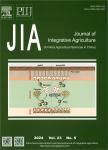Effects of nitrogen application rate and hill density on rice yield and nitrogen utilization in sodic saline–alkaline paddy fields
Effects of nitrogen application rate and hill density on rice yield and nitrogen utilization in sodic saline–alkaline paddy fields作者机构:Heilongjiang Provincial Key Laboratory of Modern Agricultural Cultivation and Crop Germplasm Improvement/Daqing Key Laboratory of Saline-alkaline Land Utilization and Improvement/College of AgricultureHeilongjiang Bayi Agricultural UniversityDaqing 163319P.R.China
出 版 物:《Journal of Integrative Agriculture》 (农业科学学报(英文版))
年 卷 期:2021年第20卷第2期
页 面:540-553页
核心收录:
学科分类:0710[理学-生物学] 0832[工学-食品科学与工程(可授工学、农学学位)] 0830[工学-环境科学与工程(可授工学、理学、农学学位)] 1004[医学-公共卫生与预防医学(可授医学、理学学位)] 0905[农学-畜牧学] 0906[农学-兽医学] 09[农学] 0901[农学-作物学] 0703[理学-化学] 0902[农学-园艺学] 0713[理学-生态学]
基 金:financially supported by the the National Key Research and Development Program of China(2016YFD0300104) the Heilongjiang Bayi Agricultural University Program for Young Scholars with Creative Talents,China(CXRC2017001) the Heilongjiang Bayi Agricultural University Support Program for San Heng San Zong,China(TDJH201802) the Graduate Innovative Research Projects,China(YJSCX2019-Y104)
主 题:rice yield saline–alkaline soil nitrogen accumulation paddy field Songnen Plain
摘 要:Soil salinity and alkalinity can inhibit crop growth and reduce yield,and this has become a global environmental *** changes in nitrogen (N) application and hill density can improve rice yields in sodic saline–alkaline paddy fields and protect the *** investigated the interactive effects of N application rate and hill density on rice yield and N accumulation,translocation and utilization in two field experiments during 2018 and 2019 in sodic saline–alkaline paddy *** N application rates (0 (control),90,120,150,and 180 kg N ha^(-1) (N0–N4),respectively) and three hill densities(achieved by altering the distance between hills,in rows spaced 30 cm apart:16.5 cm (D1),13.3 cm (D2) and 10 cm (D3))were utilized in a split-plot design with three *** application rate and hill density significantly affected grain *** mathematical model of quadratic saturated D-optimal design showed that with an N application rate in the range of 0–180 kg N ha^(-1),the highest yield was obtained at 142.61 kg N ha^(-1) which matched with a planting density of 33.3×10^(4) ha^(-1).Higher grain yield was mainly attributed to the increase in panicles m^(–2).Nitrogen application rate and hill density significantly affected N accumulation in the aboveground parts of rice plants and showed a highly significant positive correlation with grain yield at *** full heading to maturity,the average N loss rate of the aboveground parts of rice plants in N4 was 70.21% higher than that of *** is one of the reasons why the yield of N4 treatment is lower than that of the N3 *** accumulation rates in the aboveground parts under treatment N3 (150 kg N ha^(-1)) were 81.68 and 106.07% higher in 2018 and 2019,respectively,than those in the *** N translocation and N translocation contribution rates increased with the increase in the N application rate and hill density,whereas N productivity of dry matter and grain first increased



